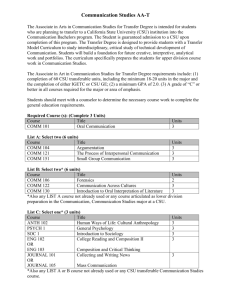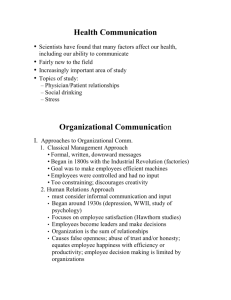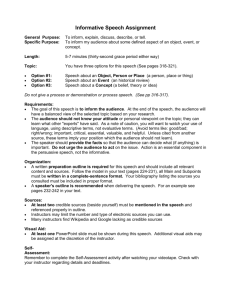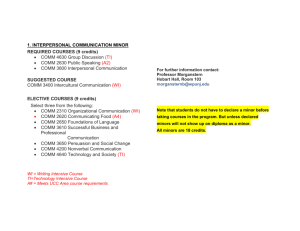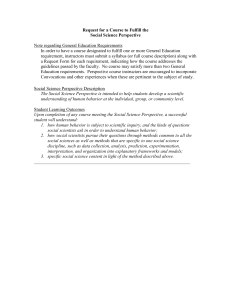Communication - Berkeley City College
advertisement
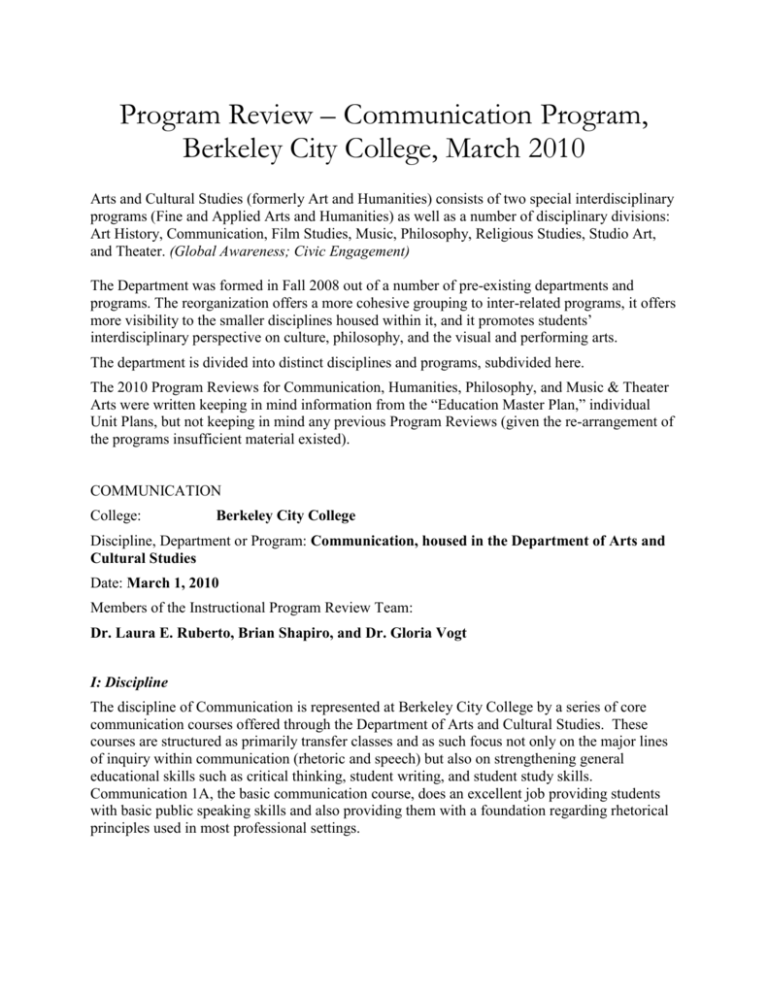
Program Review – Communication Program, Berkeley City College, March 2010 Arts and Cultural Studies (formerly Art and Humanities) consists of two special interdisciplinary programs (Fine and Applied Arts and Humanities) as well as a number of disciplinary divisions: Art History, Communication, Film Studies, Music, Philosophy, Religious Studies, Studio Art, and Theater. (Global Awareness; Civic Engagement) The Department was formed in Fall 2008 out of a number of pre-existing departments and programs. The reorganization offers a more cohesive grouping to inter-related programs, it offers more visibility to the smaller disciplines housed within it, and it promotes students’ interdisciplinary perspective on culture, philosophy, and the visual and performing arts. The department is divided into distinct disciplines and programs, subdivided here. The 2010 Program Reviews for Communication, Humanities, Philosophy, and Music & Theater Arts were written keeping in mind information from the “Education Master Plan,” individual Unit Plans, but not keeping in mind any previous Program Reviews (given the re-arrangement of the programs insufficient material existed). COMMUNICATION College: Berkeley City College Discipline, Department or Program: Communication, housed in the Department of Arts and Cultural Studies Date: March 1, 2010 Members of the Instructional Program Review Team: Dr. Laura E. Ruberto, Brian Shapiro, and Dr. Gloria Vogt I: Discipline The discipline of Communication is represented at Berkeley City College by a series of core communication courses offered through the Department of Arts and Cultural Studies. These courses are structured as primarily transfer classes and as such focus not only on the major lines of inquiry within communication (rhetoric and speech) but also on strengthening general educational skills such as critical thinking, student writing, and student study skills. Communication 1A, the basic communication course, does an excellent job providing students with basic public speaking skills and also providing them with a foundation regarding rhetorical principles used in most professional settings. There is currently one full-time instructor in Communication; however, he is resigning (as of Summer 2010) and has already been on leave for the last 3 out of 4 semesters. The discipline suffers without at least one full-time instructor to guide the curriculum and a replacement hire is badly needed. Communication courses at BCC are also part of degrees, certificates and cohort programs at the college (i.e. PACE and the Liberal Arts AA). The Communication Department currently offers no associate degrees or certificates. The majority of sections of Communication classes offered at the college are those classes required of students for transfer through IGETC, primarily Introduction to Speech and Interpersonal Communication, but also including Public Speaking, Persuasion/Critical Thinking, and the Dynamics of Group Discussion. Interpersonal Communication, Intercultural Communication, and Oral Interpretation of Literature are elective classes. Recommendations -Immediate hiring of a full-time instructor (replacement hire) -Create online courses: Develop an on-line course for Communication 20, Interpersonal Communication Skills. This is necessary to address the challenges on-line communication has on traditional didactic interactions. II. Curriculum The Communication curriculum is current and effective, reflecting recent trends within the discipline and keeping in mind the changing needs of BCC’s student. The majority of sections of Communication classes offered at the college are those classes required of students for transfer through IGETC, primarily Introduction to Speech and Interpersonal Communication, but also including Public Speaking, Persuasion/Critical Thinking, and the Dynamics of Group Discussion. Interpersonal Communication, Intercultural Communication, and Oral Interpretation of Literature are elective classes. Recommendations - To standardize our course content and provide consistency in our approaches and evaluation at each course level, it is imperative that we hire a fulltime instructor. Part-time teachers, many of whom work at several campuses, cannot participate in many of the department’s activities and discussions where rubrics and standards are developed. We must have one fulltime instructor. -Develop and offer online courses. -Additional courses developed and offered -Complete the course outline review of all courses and determine if any courses need to be updated or deactivated. II. Instruction: Each classroom at BCC is equipped with the latest in video projection and internet access. This allows communication instructors to demonstrate on-line research skills to students. Also, given the proliferation of multi-media presentations in the professional world, students now have the ability to practice those skills in a classroom setting. Finally, the ability to incorporate on-line resources in the classroom provides a flexibility in accessing and sharing content. Communication instructors hold students to the highest standards. Given communication skills are noted as vital for personal and professional advancements, the faculty strive to teach these skills as part of an individual’s basic life experiences. Course syllabus are annually shared and reviewed to help maintain department consistency. Enrollment continues to exceed availability, especially in COMM 1A and COMM 20. Evidence includes regularly full classes prior to the first day as well as students clamoring to add the class. As long as COMM 1A and COMM 20 are transferrable classes, those enrollments will remain exceedingly high. Overall, there has been over a 30% increase in enrollment since the last program review in 2007. Courses are offered to accommodate both daytime and evening students, with a conscious effort made to offer highly-demanded classes on a mix of days and times. Recommendations -Hire a fulltime contract faculty to replace the instructor who is resigning. -Keep COM 1A/COM 45 enrollment at a maximum of 30 students, in order to provide enough time for all students to practice their public speaking skills. Music instructors should be encouraged to stay active in their fields and take advantage of any available funding (staff development) to attend discipline-specific conferences or enroll in disciplinary professional associations, etc. -Communication instructors should be encouraged to incorporate new media and new pedagogical methods into their teaching through proper administrative support of such training and implementation. - The program should meet more regularly, even informally among instructors teaching similar subjects, in order to exchange ideas and teaching approaches. 5. Student Success: Retention rate of over 73%, a 5% increase since 2007. Student retention is always a priority, and Communication works within BCC guidelines to help with retention. As previously noted, limiting classroom size to 30 will help in COMM 1A. BCC does a good job in accommodating students with specific disabilities. Regularly scheduled assignment, assessment, and analysis are used to monitor student progress. Currently developing evaluation methods to measure students success in relation to specific course SLO’s STUDENT LEARNING OUTCOMES have been written. (see taskstream) The course outlines need to be reviewed. Assessment of the courses or the program has not begun yet. Recommendations. - Complete the SLOs and begin assessment. -Review all course outlines -Work with counselors to better connect students to appropriate courses - Improve the marketing of the course offerings. ________________________________________________________________________ 6. Human and Physical Resources (including equipment and facilities) Currently have one full-time Communication instructor, who is resigning effective June 2010, and 4 PT faculty members. Each classroom at BCC is equipped with the latest in video projection and internet access. This allows communication instructors to deomonstrate on-line research skills to students. Also, given the proliferation of multi-media presentations in the professional world, students now have the ability to practice those skills in a classroom setting. Finally, the ability to incorporate on-line resources in the classroom provides a flexibility in accessing and sharing content. Replacement hire for the FT Communication position is essential, as there will be no full-time faculty in Communication otherwise. Maintaining a regular and reliable PT pool is also essential. Recommendations -Replacement hire for the Fulltime Communication instructor should happen immediately. -All Communication courses should be offered in 2050 Center Street unless offsite locations have current technology easily accessible in the classroom. -We would like adequate office space for both fulltime and part-time instructors. ______________________________________________________________________________ 7. Community Outreach and Articulation For transfer programs: The following are the Communication courses that are transferrable: COMM 1A-Introduction to Speech (IGETC, Area I, Group. C; CSU, A-1) COMM 2A- The Fundamentals of Oral Interpretation of Literature (CSU C-2) COMM 4- Dynamics of Group Discussion (IGETC, Area I, Group C; CSU A-1) COMM 5- Persuasion and Critical Thinking (IGETC, Area I, Group B) COMM 6- Intercultural Communication (IGETC, Area 4; U.C. Berkeley, 7; CSU D) COMM 20- Interpersonal Communication Skills (CSU A-1) COMM 45- Public Speaking (IGETC, Area I, Group C; CSU A-1) The Program in communication ensures that the curriculum responds to the needs of the constituencies that it serves by keeping into close communication with the four-year public and private universities within our service area. Recommendations -Continue to find ways to collaborate and dialogue with four-year universities, community organizations, high schools, and private institutions.
